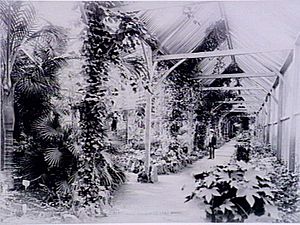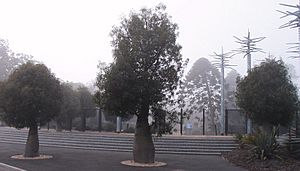Geelong Botanic Gardens facts for kids
Quick facts for kids Geelong Botanic Gardens |
|
|---|---|

Fernery at the Geelong Botanic Gardens, (1892-1902)
|
|
| Type | Botanical |
| Location | Geelong, Victoria |
| Area | 7 hectares (17 acres) |
| Owned by | City of Greater Geelong |
| Collections | Pelargonium (OPCAA registered collection), Salvia (OPCAA registered collection), Heritage Roses, Indigenous Plants- Regional collection |
| Website | http://www.geelongaustralia.com.au/gbg/ |
The Geelong Botanic Gardens is a beautiful botanical garden located in the city of Geelong, Victoria, Australia. It's found within Eastern Park, on the edge of the city center. These gardens were started in 1851, making them the fourth oldest botanic garden in Australia.
History of the Gardens
The area for the gardens was first set aside for public use in 1850. At that time, it covered the entire space of what is now Eastern Park. Later, the botanic gardens were made into a special fenced-off area in the middle of the park.
By the late 1800s, the gardens had many cool features. These included a large wooden fernery, about 4.8 kilometers (3 miles) of paths for carriages, an aviary (a place for birds), a house for monkeys, and even a place to raise fish.
The first person in charge of the gardens was Daniel Bunce. He was named the curator (the person who manages the collections) in 1857. In 1859, a conservatory (a glass building for plants) and a greenhouse were built in the gardens. After Bunce passed away in 1872, John Raddenberry became the new curator.
A special fernery opened in October 1885. It was a large structure, about 37 meters (120 feet) long and 18.5 meters (60 feet) wide. This fernery was located where the George M. Hitchcock Fountain stands today. It was made even bigger in 1886 with an octagon-shaped section that was 18.5 meters (60 feet) tall, with a pond underneath. A third part was added in 1887, making the total length about 92 meters (300 feet). By 1920, the ferns had grown very large. The wooden fernery was taken down sometime after World War II because it was getting old and falling apart.
Modern Gardens: What's New?
The gardens got a big update in 2002. A new section was opened for plants that grow well in dry climates (arid-climate plants) and plants that are native to the local area. This new part has a really cool entrance with Queensland Bottle Trees (Brachychiton rupestris). These trees have unique shapes and are combined with modern garden sculptures.
Some special plants, like Livistona mariae and Macrozamia macdonnellii, were featured in an exhibition. These plants are from Central Australia.
See also
 In Spanish: Jardín botánico de Geelong para niños
In Spanish: Jardín botánico de Geelong para niños


